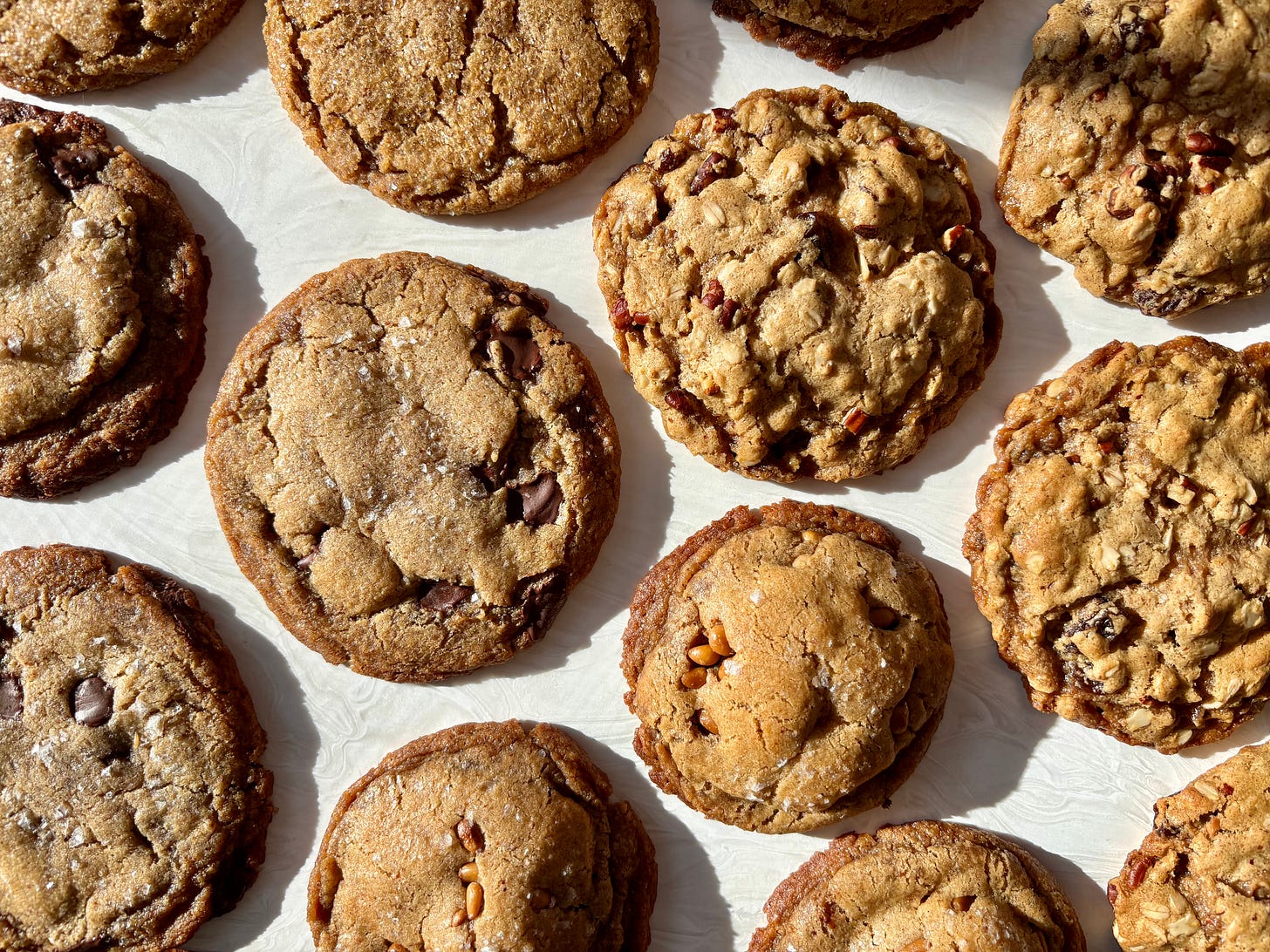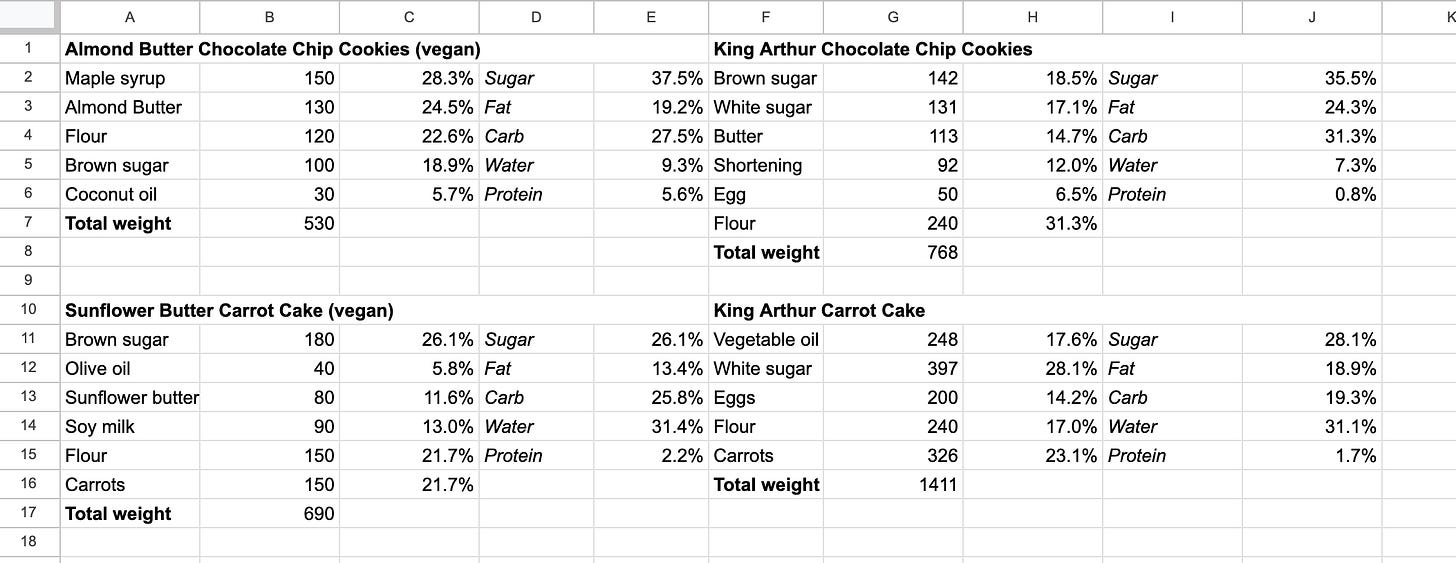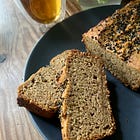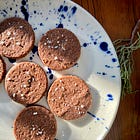Nuts Are My Butter
My approach to vegan baking
Recently my vegan cookie recipe was featured in one of my favorite food Substacks, Vittles Magazine. The recipe is for a base cookie dough that can be adapted into a wide variety of cookies: my favorite is chocolate chip, but I also included an oatmeal raisin, ginger-spice, and a pine nut one similar to the Italian pignoli cookie. The secret ingredient in the recipe is nut butter (almond butter in this case), which provides most of the fat but also acts as a binder, thus neatly taking the place of butter and eggs in a traditional cookie recipe.
I can’t even remember when I started using nut butter this way, but I’ve come to realize just how significant nuts and seeds are to my style of baking. I toast pecans and grind them to add a bit of browned-butter flavor; I work them into pie crusts and use them as the basis for shortbread; I sneak nut butter, sunflower seed butter, and tahini into cakes, cookies, brownies, and blondies. Often, the nuts don’t read as nuts in these baked goods but are there to add richness and do the heavy lifting that animal products do in conventional baking. I think what I’m saying is: Nuts are my butter.
I’m certainly not the first baker to rely on nuts like this, but I haven’t seen anyone explicitly write about their approach, so I wanted to share what I’ve learned. If you want the recipe for the “case study” sunflower butter carrot cake I describe here, become a paid subscriber and you’ll get it next week! (Or just refer a friend and you can read for free.)
First, let’s talk about the chemistry a little bit: You can reduce most baked goods to their levels of sugar, fat, carbohydrate, and water, all of which affect the composition of the final product. Fat carries flavor and inhibits gluten development; sugar helps trap moisture and facilitates caramelization; carbs — flour, usually — contribute to structure when combined with water. Cookies and brownies owe their chewy-gooey texture to a higher fat and sugar content, while cakes and quickbreads use less fat and more liquid in their batter to allow for gluten development.
Nut butters can vary in makeup, but most are roughly 55% fat, 20% carbohydrate, and 25% protein. So when you’re adding a nut butter into a recipe, you’re replacing some of the fat but also a bit of the carbs and have to adjust the amounts of oil/butter and flour accordingly. I had figured this out intuitively in my recipe development, but I decided to break down some of my recipes into their macros and compare them to conventional recipes. Here’s my vegan almond butter chocolate chip cookie compared to the King Arthur classic chocolate chip cookie, and my sunflower butter carrot cake compared to the King Arthur carrot cake:
I don’t really develop recipes using this kind of math, but it was pretty cool to see that what I’d come up with through experimentation more or less matches up chemically.
So why not use oil as the single source of fat for vegan baked goods? Sometimes I do, as in the porridge muffins I published last week or in an olive oil cake, where the oil is providing a lot of flavor. But I’ve found a flatness to other recipes, especially if they don’t rely on any strong flavorings. Nuts — especially when roasted — add a kind of background depth and, well, nuttiness, that I think enhances the flavor of the flour.
The other benefits I’ve seen are in texture. Baked goods made with nut butter tend to be softer or chewier and stay moist longer than those made with just oil. I’m still trying to reason through exactly how this works, so I turned to the best vegan baker I know, Gan Chin Lin. She pointed to the hygroscopic nature of nut butters (hygroscopic = absorbing water; think of how much water you need to add to tahini to get it to loosen up), which explains some of the moisture retention. She added that tahini and sunflower butter (as well as peanut butter and cashew butter) naturally contain lecithin, which is a stabilizer and emulsifier that leads to a tender crumb and less drying over time. Lin uses tahini for this purpose in her vegan brioche recipe.
The sunflower butter carrot cake recipe I’m sharing next week is incredibly moist (how I think a carrot cake should be) despite not having a ton of sugar, which is usually what contributes to a cake’s texture. The sunflower taste intentionally blends into the background so that it comes across as a conventional carrot cake (versus this sorghum pecan torte, in which the pecans are bold and aromatic). Like butter, nuts can take center stage or act as supporting characters, according to the goals of the recipe.
When adding nuts into my recipes, there are a few different techniques I rely on:
Whisking nut butter into sugar/oil, and then combining with dry ingredients.
This creates an emulsion that traps the moisture and fat, which hydrates the flour evenly. In cookies, it allows you to make a soft dough that isn’t too crumbly to work with. I use this technique in the vegan cookie and sunflower cake described above, as well as these peanut butter blondies and sweet potato sesame bread.
Grinding nuts with flour.
This technique is explained in Philip Khoury’s A New Way to Bake (though I’d been doing it myself already). Putting nuts (ideally roasted) into a food processor with flour “extract[s] their oils and flavour, plus it also coats the gluten, making the cookie or sponge softer.” In a lower-fat baked good like a cake, coating the flour with oil creates the tender crumb we look for, and in a higher-fat baked good like shortbread, it leads to crumbliness. I use this technique in these orange-fennel tea biscuits and toasted pecan linzer cookies.
Adding nut flour to the flour mix.
Almond flour and sunflower flour (did you know that was a thing? You’ll be seeing it in future newsletters) contain less fat than their “butter” counterparts, but are still higher in fat that wheat flour, and their addition into a flour mix makes the crumb more tender. In her book about vegan and gluten-free baking, Katerina Cermelj explains that a small amount of almond flour in cakes helps avoid gumminess: “Adding 20g of almond flour per 120g of gluten-free flour blend is enough to transform gluten-free cakes, cupcakes, muffins, and pancakes from strangely gummy and rubbery to absolutely perfect, with a soft, tender, plush crumb that melts in your mouth.” I use almond flour this way in my sticky sorghum pudding.
I would love to hear how you use nuts in your baking, or whether you’ve come across similar examples of replacing butter with nut butter. I’m planning to dive deeply into nut flours in the coming months, so send me your almond/hazelnut/chestnut flour recipes!
What I’m Cooking
Ironically, a rare recipe that is nut free! (Well, I like it with sunflower seeds mixed-in.) This recipe is built around the taste of my favorite grain porridge, from Wild Hive Farm.
Porridge Muffins (v)
Wild Hive Farm is a grain project and mill where I’ve been sourcing my flour since moving up to the Hudson Valley. It was started in the 1980s by this guy Don, who is a bit of a legend, and whom I hope you’ll get to hear from in a future newsletter. I love all the flour - the rye, spelt, and oat have become my favorites - but they also sell a







All so cool. Is it rising the cost of your baked goods? I hear “nuts” and think “expensive” lol
Ah, I love a chart like this, thank you!! I find oil seeds especially (pumpkin, sesame, watermelon seeds if you can find them, prob sunflower?) do so many of the same things eggs do as well. Love em.